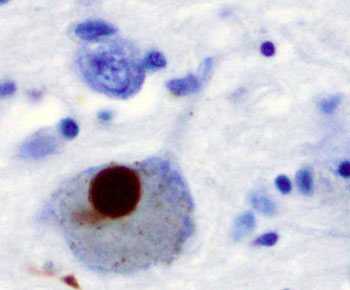Bifunctional Dimer Drugs Prove Effective in Parkinson's Disease Yeast Model
By LabMedica International staff writers
Posted on 11 Oct 2016
A team of Canadian neurodegenerative disease researchers used a yeast model system to identify novel drug compounds that were able to block the misfolding of alpha- synuclein (AS) protein, which characterizes the neurons of patients with Parkinson's disease.Posted on 11 Oct 2016
The misfolding of alpha-synuclein is a critical event in the death of dopaminergic neurons and the progression of Parkinson’s disease. Investigators at the University of Saskatchewan (Saskatoon, Canada) based their search for new drug candidates on previous studies showing that caffeine had a protective effect against Parkinson’s disease.

Image: Positive alpha-synuclein staining of a Lewy body from a patient with Parkinson\'s disease (Photo courtesy of Wikimedia Commons).
The investigators synthesized 30 different “bifunctional dimer” drugs that were attached to a caffeine scaffold structure. In addition to the caffeine scaffold, the drug compounds were augmented by the addition of reagents with known effects, such as nicotine, the diabetes drug metformin, and aminoindan, a research chemical similar to the Parkinson’s drug rasagiline.
The ability of the dimers to interact with alpha-synuclein in a cell system was assayed in a yeast Parkinson's disease model, which expressed an AS-GFP (alpha-synuclein-Green Fluorescent Protein) construct under the control of a galactose promoter.
Results published in the September 27, 2016, online edition of the journal ACS Chemical Neuroscience revealed that while the yeast strain could not grow in the presence of five millimolar galactose and displayed large cytoplasmic foci under fluorescent microscopy, two of the dimers enabled the yeast to grow normally in five millimolar galactose, and the AS-GFP became localized to the periphery of the cell. Both dimers were superior when compared to the monomeric compounds.
“Many of the current therapeutic compounds focus on boosting the dopamine output of surviving cells, but this is effective only as long as there are still enough cells to do the job,” said senior author Dr. Jeremy Lee, professor of biochemistry at the University of Saskatchewan. “Our approach aims to protect dopamine-producing cells by preventing alpha-synuclein from misfolding in the first place. Our results suggest these novel bifunctional dimers show promise in preventing the progression of Parkinson’s disease.”
Related Links:
University of Saskatchewan














